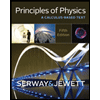A rocket car is traveling at a constant speed of 250 km/h on a salt flat. The driver gives the car a reverse thrust, and the car experiences a continuous and constant deceleration of 8.25 m/s^2. How much time elapses until the car is 175 m from the point where the reverse thrust is applied? Describe the situation for your answer.
A rocket car is traveling at a constant speed of 250 km/h on a salt flat. The driver gives the car a reverse thrust, and the car experiences a continuous and constant deceleration of 8.25 m/s^2. How much time elapses until the car is 175 m from the point where the reverse thrust is applied? Describe the situation for your answer.
Principles of Physics: A Calculus-Based Text
5th Edition
ISBN:9781133104261
Author:Raymond A. Serway, John W. Jewett
Publisher:Raymond A. Serway, John W. Jewett
Chapter2: Motion In One Dimension
Section: Chapter Questions
Problem 28P: In a classic clip on Americas Funniest Home Videos, a sleeping cat rolls gently off the top of a...
Related questions
Question
A rocket car is traveling at a constant speed of 250 km/h on a salt flat. The driver gives the car a reverse thrust, and the car experiences a continuous and constant deceleration of 8.25 m/s^2. How much time elapses until the car is 175 m from the point where the reverse thrust is applied? Describe the situation for your answer.
Expert Solution
This question has been solved!
Explore an expertly crafted, step-by-step solution for a thorough understanding of key concepts.
This is a popular solution!
Trending now
This is a popular solution!
Step by step
Solved in 7 steps with 4 images

Knowledge Booster
Learn more about
Need a deep-dive on the concept behind this application? Look no further. Learn more about this topic, physics and related others by exploring similar questions and additional content below.Recommended textbooks for you

Principles of Physics: A Calculus-Based Text
Physics
ISBN:
9781133104261
Author:
Raymond A. Serway, John W. Jewett
Publisher:
Cengage Learning

Principles of Physics: A Calculus-Based Text
Physics
ISBN:
9781133104261
Author:
Raymond A. Serway, John W. Jewett
Publisher:
Cengage Learning